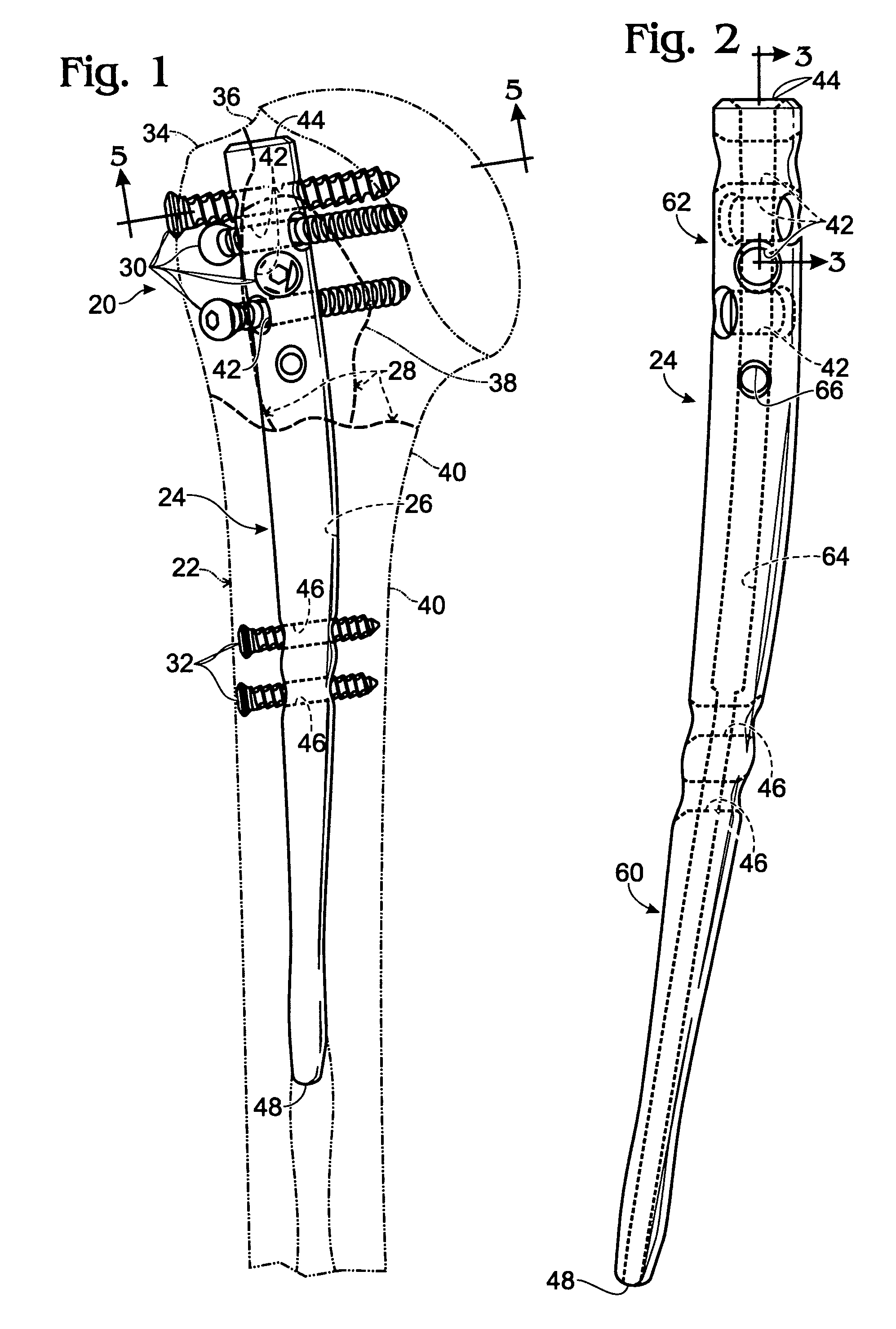Orthopedic rod with locking aperture
a technology of locking aperture and orthopedic rod, which is applied in the field of orthopedic rod with locking aperture, can solve the problems of inconvenient rotational (and thus axial) disposition of the locking aperture relative to the internal thread of the aperture, less effective non-locking aperture for fixing the rod, and less effective use of the locking aperture for the surgeon
- Summary
- Abstract
- Description
- Claims
- Application Information
AI Technical Summary
Benefits of technology
Problems solved by technology
Method used
Image
Examples
example 1
Exemplary Intramedullary Rod
[0052]This example describes an exemplary intramedullary rod for bone fixation and an exemplary bone screw for connecting the rod to bone by threaded engagement with a multi-threaded aperture of the rod; see FIGS. 2-5. Other aspects of the intramedullary rod and bone screw shown in these figures are described elsewhere in the present teachings, particularly near the beginning of the Detailed Description in relation to FIG. 1.
[0053]FIG. 2 shows intramedullary rod 24 in the absence of bone and fasteners. The rod may have any suitable shape. For example, the rod may have a leading end 48 that is placed first into the medullary canal of a bone, in an anterograde (proximal to distal) (or retrograde (distal to proximal)) approach, and a trailing end 44 disposed opposite the leading end. The trailing end may be generally planar or flat, as shown here, or may be rounded. The rod may taper toward the leading end, along a portion or all of its length, such that the...
example 2
Exemplary Relationships between Internal and External Threads
[0067]This example describes exemplary relationships between the internal thread structure of a rod aperture and an external thread of a threaded fastener, and how these relationships may affect the threadability of the threaded fastener into the rod aperture; see FIGS. 6 and 7.
[0068]FIGS. 6 and 7 show somewhat schematic representations of orthopedic rods 180, 182 including respective multi-threaded aperture 184 and single-threaded aperture 186, each having the same thread pitch. Each aperture is shown with an exemplary bone screw 188 at an early stage of threaded management into the aperture via an external thread 190.
[0069]In aperture 184, the external thread can be received alternatively in each of three internal threads 192-196 separated by only one-third, indicated at 198, of the pitch of each internal thread. Accordingly, as bone screw 188 reaches aperture 184 during placement of the bone screw into the aperture from...
example 3
Bone Screw for Locking Apertures
[0071]The following example describes an exemplary bone screw that may be suitable for insertion into, and / or threaded engagement with, the locking (and / or nonlocking) apertures of the present teachings.
[0072]The bone screw may have a shank with an external thread (a helical rib) extending along a portion or at least substantially all of the shank. The external thread may have a pitch that is about the same as the pitch of the internal thread(s) of an aperture into which the bone screw is placed. The external thread may include a land of measurable width (measured parallel to the long axis of the screw). Furthermore, the external thread may extend adjacent an axially offset helical flute. The flute may include an arcuate profile and / or an angular profile. Opposing walls of the flute (the walls of adjacent ridges) may define any suitable angle.
[0073]The bone screw may have a shank with a major diameter and a minor diameter. The major diameter may be de...
PUM
 Login to View More
Login to View More Abstract
Description
Claims
Application Information
 Login to View More
Login to View More - R&D
- Intellectual Property
- Life Sciences
- Materials
- Tech Scout
- Unparalleled Data Quality
- Higher Quality Content
- 60% Fewer Hallucinations
Browse by: Latest US Patents, China's latest patents, Technical Efficacy Thesaurus, Application Domain, Technology Topic, Popular Technical Reports.
© 2025 PatSnap. All rights reserved.Legal|Privacy policy|Modern Slavery Act Transparency Statement|Sitemap|About US| Contact US: help@patsnap.com



